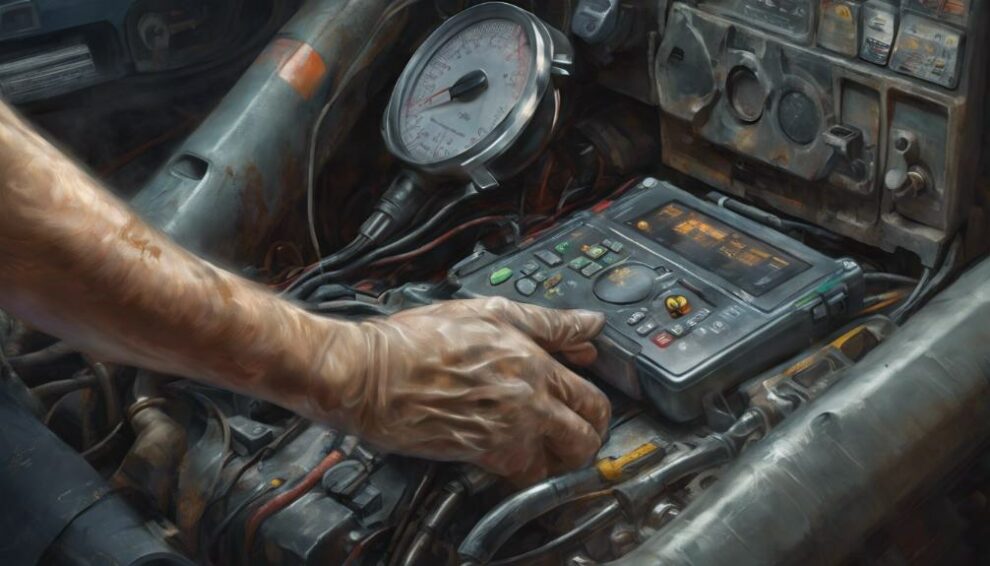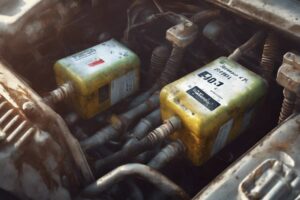When faced with a P0717 code, diagnosing turbine input shaft speed sensor failures is crucial for resolving transmission issues effectively.
Begin by conducting thorough sensor testing to pinpoint the root cause accurately. Check wiring for damage, corrosion, or disconnection.
Utilize a multimeter to measure sensor resistance and voltage output, comparing values with manufacturer’s specifications. If the sensor fails the tests, replace it to resolve the P0717 code.
Guarantee location access near the transmission case, disconnect the battery, detach the wiring harness, fit the new sensor securely, and double-check connections before reassembly.
These steps will help in addressing and repairing the issue effectively.
Key Points
- Thorough sensor testing essential for accurate diagnosis.
- Check wiring for damage, corrosion, or disconnection.
- Measure sensor resistance and voltage output using a multimeter.
- Compare values with manufacturer’s specifications for accuracy.
- Replace sensor if it fails tests to resolve P0717 code.
Understanding the P0717 Code

When diagnosing the P0717 code in your vehicle, understanding the importance of this code is essential for addressing potential turbine input shaft sensor failures effectively.
Interpreting sensor readings accurately is key to pinpointing the issue. The input speed sensor, also known as the turbine speed sensor, plays a vital role in monitoring the transmission’s input speed in RPM.
Troubleshooting electrical connections associated with this sensor is a fundamental step in resolving the P0717 code.
To begin, carefully examine the sensor readings to determine if there are any irregularities or inconsistencies. Next, focus on checking the electrical connections related to the input speed sensor.
Confirm all connections are secure, free of corrosion, and undamaged. Any faults in these connections can disrupt the sensor’s functionality, leading to the triggering of the P0717 code.
By methodically analyzing the sensor data and evaluating the electrical connections, you can effectively diagnose and address turbine input shaft sensor failures associated with the P0717 code.
Common Causes and Symptoms of P0717
To identify common causes and symptoms of P0717, focus on recognizing signs such as delayed shifting and abnormal idling RPM.
Code P0717 typically points to issues with the Input/Turbine Speed Sensor Circuit in the transmission.
When this sensor fails, it can result in delayed gear shifting, where the transmission takes longer to engage into the correct gear.
Another symptom to watch for is abnormal idling RPM, where the engine speed fluctuates unexpectedly when the vehicle is stationary. These issues indicate potential speed sensor failures that need immediate attention.
Ignoring these symptoms could lead to more severe problems like transmission slipping and damage.
Proper sensor troubleshooting is essential to pinpoint the exact cause of the P0717 code. Seeking assistance from a qualified mechanic for diagnosis and repair is important to address speed sensor issues effectively.
Diagnosing P0717 Issues

Diagnosing P0717 issues involves conducting thorough sensor testing to pinpoint the root cause accurately.
Begin by checking the wiring connected to the turbine input shaft speed sensor for any signs of damage, corrosion, or disconnection.
Confirm the wiring harness is securely attached and free of debris that could interfere with the sensor’s operation.
Next, proceed with sensor testing to evaluate its functionality. Use a multimeter to measure the sensor’s resistance and voltage output according to the manufacturer’s specifications.
Compare the obtained values with the recommended ranges to determine if the sensor is working correctly. If the sensor fails these tests, it may need replacement to resolve the P0717 code and restore proper transmission function.
Properly diagnosing P0717 issues is essential to prevent further damage to the transmission and avoid costly repairs down the road.
By following these steps diligently, you can efficiently address the concerns related to the turbine input shaft speed sensor.
Are Turbine Input Shaft Speed Sensor Failures and Wheel Speed Sensor Failures Related?
When dealing with wheel speed sensor failures symptoms solutions, it’s important to consider whether turbine input shaft speed sensor failures are related. While both are crucial for vehicle performance, they are not directly linked. Wheel speed sensor failures can stem from wiring issues or sensor malfunctions, whereas turbine input shaft speed sensor failures may result from transmission problems.
Replacing Turbine Input Shaft Sensor
If replacing the Turbine Input Shaft Sensor, make sure to have proper location access near the transmission case. The sensor is typically located on the transmission housing, near the input shaft.
To replace it, you may need to remove some components for better reach. Guarantee the vehicle is safely lifted and properly supported before starting the replacement process.
For a DIY replacement, begin by disconnecting the battery to prevent any electrical mishaps. Then, locate the sensor and carefully detach the wiring harness connected to it.
Use the appropriate tools to remove the old sensor from its position. When installing the new sensor, make certain it’s securely fitted in place.
Reconnect the wiring harness and double-check all connections before reassembling any removed parts.
Maintenance Tips for Sensor Longevity

For best sensor longevity, prioritize regular inspection and cleaning to prevent debris buildup or contaminants that could impact performance.
Sensor troubleshooting involves checking for any signs of dirt, grime, or foreign objects that could interfere with the sensor’s operation.
Preventive maintenance is key to guaranteeing the sensor functions efficiently over time. Then, make sure the sensor is properly installed to avoid damages or misalignments that may lead to malfunction.
Using high-quality transmission fluid is essential for maintaining peak sensor function and preventing premature wear.
Monitoring the sensor’s output signal regularly can help you detect any irregularities or fluctuations that may indicate a potential issue.
Following manufacturer recommendations for sensor replacement intervals is vital to ensure efficient transmission operation and avoid unexpected failures.
As an Amazon Associate we earn from qualifying purchases.










